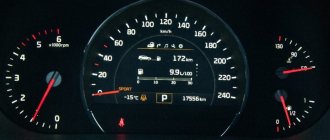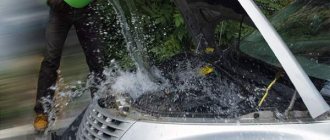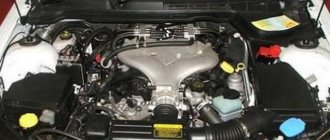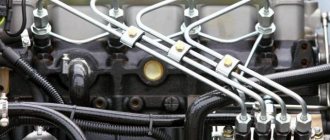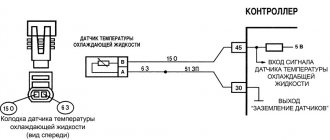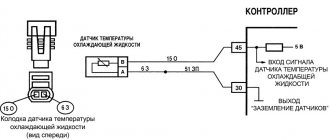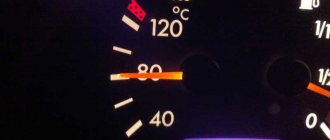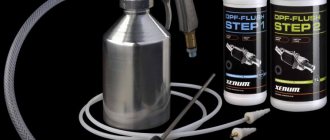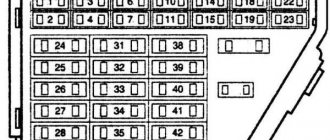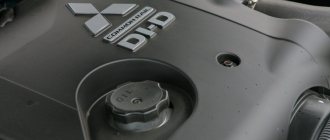A certain failure in the operation of the power unit is characterized by the concept of “the diesel engine has gone haywire.” Such a malfunction is more often a problem with diesel engines, although there have been cases when a gasoline carburetor engine was damaged.
This concept should be understood as an uncontrolled spontaneous increase in engine speed to the maximum permissible values, as a result of which the power unit actually self-destructs after several minutes of operation at the limit.
A similar operating mode can occur both after starting the engine and after a sharp reduction in the load on the engine. Diesel overrun means maximum speed (arrow in the red zone of the tachometer), loud noise during engine operation, which is accompanied by thick smoke and soot from the exhaust pipe, as well as sometimes flashes of flame.
We also recommend reading the article on how to decarbonize a diesel engine with your own hands. From this article you will learn about the causes and consequences of carbon deposits in the engine combustion chamber, as well as available methods for decoking piston rings and removing deposits from the surface of parts.
The consequences of runaway for an internal combustion engine are usually catastrophic: the engine overheats, then the unit jams as a result of overheating or destruction of parts due to increased mechanical loads, the crankshaft breaks, valves, pistons melt, etc. Running a diesel engine is also dangerous because the engine can literally explode, as the connecting rods pierce the cylinder head, break the cylinder block, and fragments fly into the engine compartment. A fire in the engine exhaust tract is also possible.
What to do if the diesel engine breaks down?
Do you know, friends, why diesel engines are called the devil's engines? No..? And what does Satan have to do with it, you ask? Here's the thing. The most common reasons for this rather biased attitude of some motorists towards this type of internal combustion engine (ICE) can be attributed to the specific nuances of its operation on diesel fuel (DF), which rumbles constantly during its operation, and also vibrates strongly and collects enough energy inside itself. a lot of soot emitted by a powerful engine from the depths of the exhaust pipe into the atmosphere. Note that recently these unpleasant nuances, once tightly associated with the diesel engines themselves, are gradually fading into the background. All modern diesel engines have now become much more environmentally friendly and have become very fond of the nature around us. However, there is another reason for this attitude of drivers and other citizens towards diesel engines. This is a certain factor that at some point they can seriously fail and go to pieces, and then everything will fall on the “card” at once, that is, your health and even human life! Therefore, this engine is considered by many citizen motorists to be “The True Satan!”
See also: Warming up a cold engine: An alternative opinion
You, friends, certainly may have once heard about such an unusual phenomenon as a diesel engine blowing up, and perhaps you yourself once had not the most pleasant moments of dealing with this phenomenon with a “frenzied diesel engine.”
Although this is rare, it still happens (the further we move from the beginning of Rudolf Diesel’s creation of his first prototype, the less common this phenomenon is). But to say this for sure, many of you may never have the chance to encounter this phenomenon. Although, to our regret, this cannot be said one hundred percent today. So friends, let’s better be fully armed and together curb (at least) in theory this uncontrolled diesel engine. see also
How to turn off a diesel engine that has gone crazy: tips
We will try to tell you in as much detail as possible about the main point, what can cause such a problem and the risks associated with it, as well as how we can quickly put an end to this rapidly developing situation .
Everything you need to know about the scandal with
What are the dangers of running a diesel engine?
An engine that has gone into overdrive, first of all, poses a danger both to the driver and to everyone around him. Firstly, a fire may occur in the exhaust manifold due to a sharp increase in temperature and fuel particles entering it. Ignition of the manifold leads to the transfer of flame to the fuel tank, which is accompanied by an explosion of the latter.
Another danger is engine overheating. Typically, during the process of overheating, parts are deformed and dimensional accuracy is seriously compromised. Thus, they become dislodged and cause the motor to jam. In this case, expensive engine repairs cannot be avoided.
Usually, after a breakdown, a major overhaul of the engine always occurs. Although, there are often cases when after this the motor is completely beyond repair.
What is diesel engine runaway?
First, a short note. -When a diesel engine goes into overdrive, this means that its speed begins to increase extremely quickly and uncontrollably and goes beyond the red line on the tachometer. At this moment, extraneous noise, black smoke, soot appear, and sometimes flames can be emitted, and all this at the same time, as a “bonus,” comes straight out of the exhaust pipe.
Turbine
Diesel can go bad for a variety of reasons. If it is a turbocharged engine, there is a high probability that this happened precisely because of this mechanism. This element is cooled by oil. Sometimes leaks occur. As a result, the mechanism is unable to provide boost. Engine speed involuntarily increases. As they increase, the oil pump begins to pump lubricant faster. As a result, it ends up in the combustion chamber. Black smoke comes out of the exhaust pipe.
With such a malfunction, the unit may be left without lubrication altogether. After all, all the oil went into the exhaust pipe. There have been cases when, even after turning off the fuel supply, the unit continued to operate purely on lubricant. And even if this process lasts no more than a minute, this is quite enough for the diesel to go to waste. This happens especially often on older military engines. They are designed for the consumption of fuel oil and kerosene. Therefore, you should not be surprised that after stopping the fuel supply, the engine continues to work. If the diesel engine goes into overdrive, the crankshaft may burst in half. It is not necessary that it will tear out the cylinder block and fly out with fragments. In some cases, the engine will continue to operate, but with characteristic knocking noises. What else happens when diesel goes into overdrive? As the speed increases, the engine temperature increases. It overheats quickly. Also, if it is a leak from the turbine, fires are possible in the exhaust manifold area. Piston jamming occurs in a matter of minutes. Moreover, it does not matter what the current inertia force of the flywheel is. Even if the car is idling, the connecting rod bolts and other elements of the crank mechanism (crank mechanism) may break.
What are the risks if the engine breaks down?
There are two ways the situation could develop. One is dangerous and the other is very unpleasant.
First option. If the engine starts to spin while driving, then the car becomes like an angry metal mustang, it begins to accelerate uncontrollably, which in the worst case can lead to an accident, and here everything depends on the level of driving skill and the instant ability to adequately respond to an extremely developing situation. If the driver is okay with this, then the consequences themselves will not go beyond the bounds of reason.
Second example. If this incident happened in a parking lot/parking lot, that is, precisely when the car is operating in neutral mode, then the engine, having reached its prohibitive speed in an abnormal operating mode, will continue to spin until it stops completely, it will simply fail. Depending on certain conditions, the motor can literally demolish its “tower”, thus tearing off the block head and subsequently scattering all its insides over the immediate surrounding area.
Action plan in case of engine malfunction
Many motorists have already developed a specific action plan that is recommended to be carried out in the event of equipment breakdown.
- If for some reason the engine speed begins to increase sharply, then it is necessary to turn off the ignition and gear. Very often the driver does not always have time to notice the increase in speed. At the initial stage of their growth, it is possible to turn off the engine in the usual way.
- If possible, move to the side of the road;
- If necessary, open the hood to gain access to the air intake;
- It is recommended to turn on the hazard lights;
- The air intake hole must be covered with thick cloth. Truckers use sweatshirts for these purposes. If there is a carbon dioxide fire extinguisher in the car, then use it. The jet is directed into the air intake. Since this gas is not flammable, the powerful flow will cause the engine to “choke,” which will lead to its stop;
- You can no longer start the engine. Otherwise, the car owner will see his engine die. The car is transported to the repair shop either by tow or by tow truck.
If for some reason the driver cannot perform these manipulations, then he should move a short distance from the car and start calling specialized services for help.
If you carry out the above steps in time, this will lead to the fact that only engine repair will be required, and possibly replacement of the turbocharger. However, there will be no other serious consequences.
Experts do not recommend repairing equipment on your own, because the slightest flaw will lead to the situation with the breakdown repeating. It is best to repair a diesel engine in specialized centers. Therefore, you should not skimp on the work of professionals, so as not to pay twice.
Such phenomena still happen during the operation of the car, so owners are interested in the reasons why the engine is running wild. Most of the cases occur in diesel engines, especially those that were produced many years ago. Modern engines, in addition to the driver, are also controlled by on-board computers, which carefully monitor the operating conditions of the power unit, do not give it excess fuel, and do not allow an uncontrolled increase in crankshaft speed.
What Causes Diesel Engine Overrun?
The speed of a gasoline engine is controlled by a throttle valve, which allows more or less air to enter the cylinders where more or less fuel is burned. In accordance with this, the engine begins to produce, either in its minimum or in its maximum range, the corresponding and necessary power. In a diesel engine, the amount of this air has no restrictions; it is, as a rule, regulated by the amount of fuel itself that is injected into the cylinders.
Thus, as long as there is air supplied and something to burn inside the cylinders themselves, the diesel engine will continue to work until one of these components runs out. And in order to completely burn the fuel, it only needs, as is known, pressure; in these cases, no sparks should appear, as in gasoline engines.
Modern diesel engines are more protected from those specific defects that cause them to go into disarray, since the amount of fuel in them is strictly calculated electronically and injected in doses. It is calculated using a computer and depends on many factors. Even if something suddenly happens to the gas pedal (electronic gas pedal), the computer will instantly “cut” the volume of fuel supplied in accordance with the required amount at idle, and this will happen exactly when you press the brake pedal. Just half a second, even a fraction of a second, will be enough for the on-board computer to immediately calculate the situation and make the only correct and correct decision for you.
However, friends, this is still not the main thing; improper operation of the accelerator pedal is the least common reason for this phenomenon. You should pay more attention to other possible causes, namely, combustible fuels that may enter the combustion chamber in addition to the existing diesel fuel.
For example, if the car is located in an area of accumulation of natural gases or propane, then this can cause the engine to run out, and it only becomes so when the gas evaporates on its own or the air supply is manually shut off. Some engines can run on coal dust and even oils. As a reminder to our motorists, we, for our part, believe that you should definitely know about this, that when the diesel engine was invented, as such, the concepts of diesel and fuel for it, i.e. solariums did not yet exist; that ancient engine ran only on vegetable oil.
Speaking about oils, it is necessary to say right away that this was the most common reason why a diesel engine began to “go crazy”. You probably, friends, will immediately want to ask us, “Who in their right mind would pour oil into the intake manifold of an engine,” but..., don’t rush and don’t get ahead of things, dear friends, don’t forget that for your proper operation The engine must consume a sufficiently large amount of oil.
Yes, no one hides the fact that motor oil is the biggest and most dangerous enemy and it can get into the engine cylinders in only two ways, namely, the first way is through the turbocharger, the second is through the crankcase ventilation tube.
Deadly auto scandals: “VW vs GM” vs “Toyota”
As many of you probably know, a turbocharger rotates at a speed equal to thousands of revolutions per minute. This is necessary primarily in order to force more air into the engine. To prevent this expensive part from breaking immediately at the start of operation, that is, after the first start of the engine, oil is used to lubricate the working group of the turbocharger and maintain normal temperatures.
And if, over time, the tightness in the engine is broken, then along with the air pumped by the turbine, oil will also get there, which means combustion in the chamber will begin to occur faster and more intensely, the engine will begin to gain speed and spin faster and faster until the lubricant completely runs out or specific self-destruction. In any position, nothing good can be expected from this.
Poor sealing usually allows engine oil to enter the engine itself, this happens through the crankcase ventilation. The crankcase is connected by hoses to the intake manifold; this is done to ventilate the resulting oil vapors during engine operation. If the piston rings are worn out and old, they will not completely seal the combustion chamber when diesel fuel ignites. From here the pressure begins to seep into the crankcase and push (pump) more and more generated vapors into the cylinder, and this happens all the time, just some kind of vicious circle..(?)
The same thing happens when an excessive amount of motor oil enters the engine, which usually leads to the same situation.
If the injection pump (high pressure fuel pump) is faulty. The fuel pump itself is driven from the engine crankshaft directly through the gearbox; its performance directly depends on the rotation speed of the engine shaft. To maintain a given engine speed, a centrifugal governor is used, which limits the fuel supply as the rotation speed increases.
If the fuel injection pump rack jams, this can lead to two unpleasant consequences, namely, in the first case, the engine will stall, in the second, it will go into overdrive.
Reasons - fuel injection pump
One of the main reasons for this phenomenon is a malfunction of the high-pressure fuel pump or rack. As a result, fuel enters the combustion chamber without restrictions. This is an uncontrolled process. And the more of it gets into the chamber, the higher the engine speed. After this, the gas distribution mechanism (often with a chain drive) does not have time to react to these changes. As a result of incorrect phase distributions, the crankshaft, intake and exhaust valves bend. The consequences in most cases are very sad. What to do if the engine breaks down?
There is only one way to save the unit - shut it down. But it is not always possible to do this with a key. You have to independently block the access of air to the combustion chamber. But in some cases, the diameter of the inlet intake hole is very large. And even with improvised means it will not be possible to close it. Air will still flow through small cracks. It is worth noting that on passenger cars the oxygen intake is located at the bottom. Therefore, you will have to cut off the supply after the air filter. To do this, unscrew the clamp with a screwdriver and stop the oxygen supply to the pipe. This needs to be done as quickly as possible. Remember that minutes count here. The second option is longer, but effective. If the engine starts to spin, it is necessary to stop the fuel supply by disconnecting the fuel line. But there is not always time for this. The consequences are bent valves and a failed crankshaft. The worst thing is that at this time fragments of the cylinder block are flying. The explosion can be compared to the effect of a grenade. It is simply dangerous to be near such a motor. But this does not happen immediately, but after 3-5 minutes of engine operation in this mode.
How to stop spreading?
To stop diesel engine runaway you will have to either reduce fuel or cut off the air supply. However, take your time, if you encounter this while driving, then increasing the mechanical load will become a priority and necessary task for you in order to normalize engine operation.
In any case, it is better to first make sure that such actions are safe.
We understand our motorists that this sounds kind of stupid in such an extreme current situation, but still, friends, try not to lose your heads.
Next, we will describe the general rule of guidance for our readers, but we will do this only theoretically. Using this guide in practice, and especially under a variety of circumstances, may not lead car owners to the desired result.
If diesel engine runaway starts while driving a car, then you should personally and certainly feel the unexpected acceleration. Take your foot off the accelerator pedal and press the brake, while trying to monitor the car following you from behind, how close it is to you, this must be done in order to avoid a collision. Never put the engine of a car above your own life (or the lives of others). Let it scream and roar with all its might and let it reach speeds unimaginable at that moment, immediately put the speed in neutral and your car will stop accelerating, and then start snuggling to the side of the road.
The most important thing is don’t panic, if you have an automatic transmission, then most automatic transmissions allow you to select neutral gear and stop right on the move.
Did you feel scared to do anything after all the time you stopped, and even more so after you personally saw what was happening? Please don’t be alarmed, friends, let the engine in the car work, sooner or later it will use up all the available fuel or simply break down due to the catalytic process of the oil entering the cylinders. In the meantime, you will concentrate and become better at calling emergency services. And please, try to warn other road users about the emergency situation that has occurred with the car.
Try not to be scared or afraid in this situation, but act immediately. The very first quick and reliable way to turn off the engine is to use a fire extinguisher, which should usually always be in the car. Grab it and immediately open the hood of the car, then spray the entire contents of the fire extinguisher right next to the intake valve. You don't know where it is? Then start spraying the entire contents of the fire extinguisher throughout the engine compartment. The CO2 concentration will replace the necessary air that is needed for fuel combustion. All this should lead to the engine stopping. This method also works in those very cases where flammable gases begin to leak and enter the atmosphere around the car itself.
If this reason turns out to be that oil got into the intake manifold, then this should certainly cause huge clouds of smoke that will come out of the exhaust pipe. If smoke begins to cover the entire car, then at this moment it is better for you to move away from it and immediately call emergency services by phone 112.
If you don’t have a fire extinguisher in your car, what should you do? There is another way to reduce the air supply to the engine. You need to manually block the air flow, that is, take a piece of some kind of rag or piece of plywood. If you close the intake valve with them, and the engine is still running, this will mean that air is still leaking somewhere around the perimeter and this is quite enough to burn fuel in the cylinders.
You can do the same with a manual transmission. You need to put it in the highest gear and then sharply press the brake and sharply release the clutch. This should create a lot of resistance and the engine should stall.
We hope, friends, that everything will work out for you.
Additional pump adjustment
If diagnostics of diesel engines shows that the mixture is not being prepared correctly, most likely the cause is the injection pump, and the centrifugal regulator cannot cope with this function. For this, a special adjustment stand is used.
Before checking, it is necessary to clean the pump from dirt and other deposits. Then the injection advance is checked using marks and the low pressure valve is diagnosed. To do this, you need to unscrew the valve and tap with a hammer (light blows) on its upper part. Next, the cyclic feed is set. It is adjusted using a locknut. If necessary, it is unscrewed or tightened and then clamped. Normal idle speed of a diesel engine is 770-790 per minute. For additional adjustment, use a hydraulic corrector by rotating its rod counterclockwise or clockwise. Timely troubleshooting ensures reliable operation of the power system and the engine as a whole.
What should you do after you have stopped the diesel engine?
Even when you did everything correctly and quickly stopped the engine, try NOT to START it again under any circumstances. If this problem catches you on the road, then park your car in a safe place, turn on the emergency lights and call a tow truck. You need to take the car to a car service center, where they will study the situation in detail and determine the cause of the illness.
If your car is parked in the middle of the road and is interfering with the passage of other vehicles, then anyway, take your time and set it to the hazard lights, or better yet, try to roll it to the side of the road WITHOUT STARTING THE ENGINE!
Our video clip above clearly shows everything that can happen when an engine runs out of control, and also how some experienced motorists were able to stop an out of control engine. And friends, there is one more precaution that we want to inform you about, namely, if you try to stop the air supply to the engine directly through the turbocharger (as the American did and as shown in the second video), then please be extremely careful not to accidentally get your fingers into the turbine rotor!
Diagnostics of diesel internal combustion engines
As mentioned earlier, the engine can spin out immediately after starting or after a sharp reduction in load. You can diagnose the malfunction using the tachometer: the idle speed will not be at a normal level. In addition, a sharp engine hum will appear, accompanied by increased emissions of black exhaust smoke.
As for driving in gear, the car will begin to pick up speed very quickly on its own. It is worth saying here that this behavior of the machine is extremely dangerous, and therefore it is necessary to take quick and decisive measures.
First of all, put the car in neutral and stop the car on the side of the road. It will be better if it is a deserted place so as not to pose a danger to others. Next you need to stop the engine. If the engine has gone into overdrive, then it will not be possible to do this in the usual way, so you need to get out of the car and forcefully turn off the engine. To do this, you can cut the fuel pipes. Thus, the fuel supply will stop and the engine will stop. The pipes are located on the gas tank or fuel rail under the hood. Which ones to chop is your choice, but it should be based on the speed of your actions.
Another way is “oxygen starvation.” It is necessary to remove the air filter, or without removing it, plug the air pipe with thick fabric or any other material. Thus, air will stop flowing into the combustion chamber and the engine will stop. Further movement is possible only in tow. Unfortunately, it is impossible to move on such an engine.
Links
- engine spacing
- article from. - Seifert, Bill.
Offshore Sailing: 200 Essential Passagemaking Tips. —McGraw-Hill Professional, 2001.
Compression ratio of a diesel engine - what is it?
A diesel engine (in common parlance - diesel) is a piston internal combustion engine that operates on the principle of self-ignition of atomized fuel under the influence of air heated during compression. It is used mainly on ships, diesel locomotives, buses and trucks, tractors, diesel power plants, and by the end of the 20th century it became widespread on passenger cars. Named after the inventor. The first engine operating on this principle was built by Rudolf Diesel in 1897.
The range of fuels for diesel engines is very wide, this includes all fractions of oil refining from kerosene to fuel oil and a number of products of natural origin - rapeseed oil, frying fat, palm oil and many others. A diesel engine can also run on crude oil with some success.
The MiG-31 (according to NATO codification: Foxhound - fox hound) is a Soviet and Russian two-seat supersonic high-altitude all-weather long-range fighter-interceptor. Developed at OKB-155 (now PJSC RSK MiG) in the 1970s. The first Soviet combat aircraft of the fourth generation.
The MiG-31 is designed to intercept and destroy air targets at extremely low, low, medium and high altitudes, day and night, in simple and adverse weather conditions, when the enemy uses active and passive radar jamming, as well as false thermal targets. A group of four MiG-31 aircraft is capable of controlling airspace with a frontal length of up to 1,100 km.
Initially, the fighter was developed to intercept aircraft cruise missiles and the then new American B-1 bombers in the entire range of altitudes and speeds, as well as low-flying satellites and automatic drifting balloons (ADA), launched by NATO countries since the 50s over the territory of the USSR.
For several years, the MiG-31 regiments had the status of special forces (SpN) as part of the air defense.
Engine knock occurs during rapid (explosive) combustion of the fuel-air mixture in the cylinder of an internal combustion engine. To the ear it is perceived as a metallic “ringing” or knocking. This is an undesirable mode of engine operation, since increased pressure and overheating occur in the cylinder, and the cylinder structural elements experience increased loads for which they were not designed, engine power decreases, and emissions of harmful substances increase. When intensely applied, these loads quickly lead to cylinder damage and engine failure.
Engine knocking is sometimes called detonation or detonation combustion of the mixture, but this name does not reflect the physics of the phenomenon. Combustion of the mixture in an engine cylinder, both when ignited by a spark and during premature self-ignition of the mixture in hot spots, as a rule, is not accompanied by the formation of detonation waves. In accordance with the amplitude of the pressure waves that occur in the cylinder during rapid combustion of the mixture, a distinction is made between the normal combustion mode (without knocking) and the mode in which knocking occurs. The latter mode, in turn, is divided into conventional knock of varying intensity and detonation knock (super-knock or deto-knock) according to peak pressure values. Detonation knock is especially undesirable, since the pressure generated in the detonation combustion wave can immediately destroy the cylinder.
The occurrence of knocking is associated with the effects of abnormal combustion of the mixture in the cylinder: self-ignition of the mixture before it is ignited by a spark or wall ignition by hot structural elements or foreign particles in the cylinder. The likelihood of knocking increases with increasing compression ratio and engine load, as well as with decreasing fuel octane number. Electronic ignition control systems are used to prevent knocking, and anti-knock additives such as MMA (monomethylaniline) or MTBE (methyl tert-butyl ether) are added to the fuel.
About the reasons for peddling
One of the most common reasons for the appearance of uncontrolled engine behavior is the appearance of malfunctions in the fuel pump. It has a fuel rail, with which the fuel supply to the cylinders is regulated. By its movement in the channel, it increases or decreases the supply of diesel fuel to the injectors. When it jams, control over the supply stops, fuel enters the cylinders without any control, and the engine instantly gains high speed.
A diesel engine can be called omnivorous, since there are models that work equally well on diesel fuel, kerosene, oil and other types of hydrocarbons. The entry of engine oil into the cylinders also leads to the operation of the power unit being out of control of the driver. There can be many reasons for this, for example, wear of the pistons and rings leads to the fact that burnt gases break into the crankcase, pick it up and push it into the combustion chamber and exhaust manifold.
As a result, the engine speed increases and the engine oil in the vehicle's exhaust system may ignite. This can also be caused by piston burnout or malfunctions in the turbine. Such malfunctions can manifest themselves in the appearance of excess oil in the intercooler or compressor, so you should monitor its presence and remove it in a timely manner.
Its excess appears through leaks, and in this case, even stopping the supply of diesel fuel will not stop the engine, since oil perfectly replaces it.
To avoid destruction of the power unit, you must immediately shut off the fuel or air supply. As you can see, the reasons why the engine goes wrong have long been known and predictable. They can be prevented if you monitor the technical condition of the power unit and all its systems.
